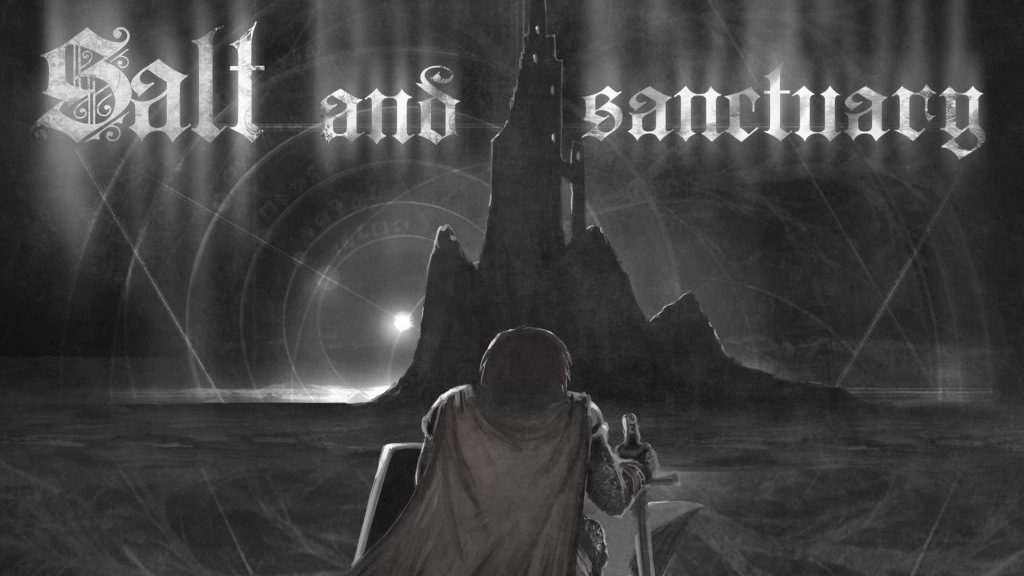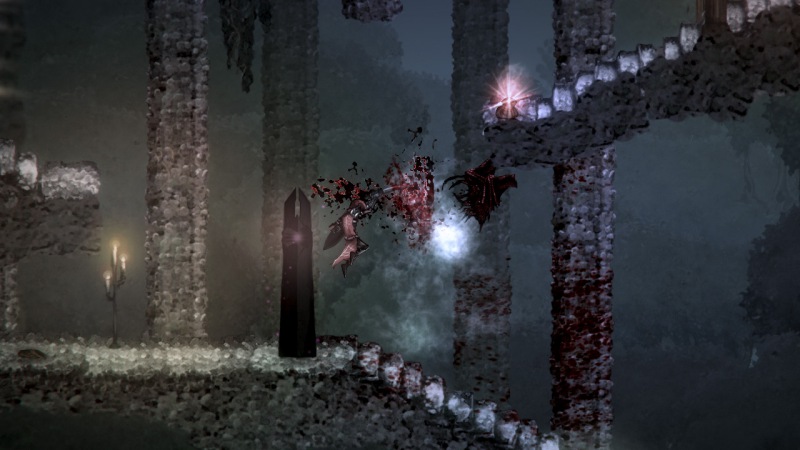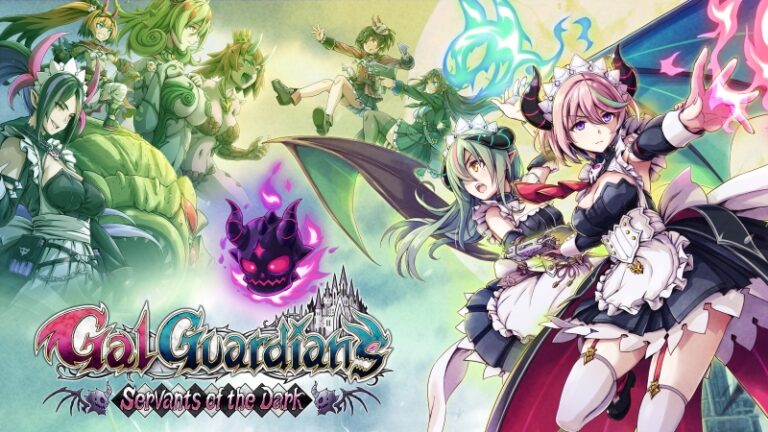
It’s difficult to talk about Salt and Sanctuary without continually comparing it to its clear inspiration: Dark Souls. From Software’s legendary RPG series has inspired plenty of imitators over the years, though none quite so blatant in tone and style as Salt and Sanctuary. By no means is that a bad thing; Ska Studios’ Salt and Sanctuary is a good game in its own right, blending the studio’s expertise in 2D character action with the Souls series’ tried-and-true formula. Despite never innovating enough to set it apart from its obvious influences, Salt and Sanctuary is a worthwhile RPG on the Nintendo Switch.
Salt and Sanctuary wastes no time throwing players right into the action. Upon starting a new game and choosing beginning stats and alignments, players engage in a brief tutorial that ends with them waking up, shipwrecked, on a mysterious island. Soon after, the game’s first sanctuary — a “safe room” of sorts where players can interact with various NPC’s and level up — is introduced. It’s essentially a bonfire from Dark Souls but with the added twist of “Offerings.” While players are out exploring the world, they come across these small statues that can be placed in any of the sanctuaries they visit. These Offerings bring in merchants, craftsmen, priests, and more, and are one of the few ways Salt and Sanctuary stands apart from its influences. Offerings are limited in quantity, and only five can be used in any sanctuary. While this sounds relatively easy, it’s a system with more depth than is initially apparent.
As an example, using an offering to summon a Guide will allow players to quickly travel to any sanctuary they’ve visited with another Guide they’ve previously summoned there, functioning as a fast travel point of sorts. This ability makes returning to previous regions to find new areas and abilities incredibly easy — but only if players use those Offerings sparingly. Using all of your Offerings in the early game can leave you with few options for healers, merchants, and more useful NPCs in your sanctuaries. This simple mistake can turn some of the harder late-game areas into absolute nightmares as you trek long distances to find the merchant with the one item that can help you.

Salt and Sanctuary also has an incredibly deep skill tree. From the start of the game, players can invest skill points from leveling up into a wide array of stats that will shape the way they play. If players are looking for a build relying solely on ranged projectiles and magic, that’s fair game. If they want something more balanced, the tree can spread out in all directions. For myself, I went with a heavy build, focusing on high defense and attack above all else. For the most part, this worked out fine. From playthrough to playthrough this style of leveling should offer plenty of expression for RPG fans who love to experiment, but once players invest enough experience down a single path, it can be hard to even things out in a way that ever feels worthwhile.
Ska Studios made their name on visceral 2D combat, and Salt and Sanctuary certainly doesn’t disappoint on that front. Managing a stamina bar during battle, players engage in simple skirmishes of blocking and attacking. Slashes and strikes land with sickening aplomb, and killing blows on wounded enemies feel particularly devastating. Players also have a horizontal dodge roll at their disposal, but unfortunately, it often got me into more trouble than I care to admit. In fact, of all the mechanics lifted directly from Dark Souls, this is the one that felt the worst.
Like Dark Souls, players are able to dodge attacks and jump to avoid damage. But in taking away the 3D plane of Dark Souls, the dodge leaves players with only the option to roll away or towards their opponents. In 1-on-1 fights, this can be a simple way to roll behind an attacking enemy and strike from their back. When more enemies jump into the mix – which happens quite often – rolling can become a death sentence. Roll behind one enemy to dodge, and players can find themselves facing another enemy already starting their attack animation. If they try to block, they will find themselves now stuck between two enemies, with stamina quickly dwindling and death drawing near. Also, I’m not sure if it is a problem exclusive to the Nintendo Switch, but I found that at times the roll was unresponsive, requiring pressing the button several times for it to input, even after switching Joycons.

I do have another qualm with the game’s 2D plane, as it doesn’t always feel fair. Dark Souls as a series has always been regarded as “tough but fair.” It has a harsh, but specific set of rules, and if you abide by them you can get along just fine. Salt and Sanctuary does its best, but it doesn’t always manage to emulate this feeling. Trying to run from an enemy can lead to worse circumstances because unlike Dark Souls, players can’t always see what’s ahead of them. I commonly found myself accidentally landing between two or more enemies with no way out.
It’s also not uncommon for enemies to swarm from offscreen or hurl projectiles from unseen positions. In small increments, these flaws are easily dealt with, but more often than not, they turn into frustration. Dying in a Souls game imparts a feeling of growth; one of the reasons the series can be so addictive is how it manages to master the “just one more time” mentality. Players are supposed to learn something new each time. Salt and Sanctuary evokes that sensation at the most basic level, but more than a few of my deaths felt like they stemmed from the game’s willingness to punish me for simply playing, rather than my unwillingness to learn.
One thing that kept my attention throughout the experience was the game’s art design. While I find the character design slightly off-putting, the world and creatures of Salt and Sanctuary are worth the price of admission for anyone who loves a well-crafted horror aesthetic. The gothic castles and foggy forests of the island are suitably foreboding; piles of infested bodies lie decomposing around every corner, and there is a constant feeling of decay and rot.
While most of the fodder enemies fall into vague bipedal monster stereotypes, the real highlight of the game is the boss designs. Each boss is initially intimidating due to its imposing size, but some of the designs are downright haunting. Blending Bloodborne‘s monster mash aesthetic with the grimy goth sensibilities of Ska Studios has led to some of the most upsetting and occasionally beautiful enemy designs this side of the Silent Hill series. The Unskinned and The Queen of Smiles were standouts for me in particular.
By this point, it should come as no surprise that Salt and Sanctuary on Nintendo Switch is a fantastic experience and an immaculate port. The game’s straightforward style and death-heavy design make it perfect for playing in short bursts or long sessions; I enjoyed both during my 30-hour or so playthrough. Except for the previously mentioned dodge issue, the controls are smooth and responsive. I was most impressed by the load times, which usually had me playing again after dying within 10 seconds or so. The visual fidelity is retained from the previous versions, and the 1 GB file size is perfect for those who are worried about the Switch’s small internal memory.
I enjoyed my time with Salt and Sanctuary, and if you enjoy challenging 2D games or just games with fantastic horror art design, you probably will too. Unfortunately, it sticks a little too close to its influences to innovate, and in some cases takes a few steps backward where games like Dark Souls succeeded. For players able to persist through some frustrating design, Salt and Sanctuary is a rewarding and content-rich experience worth the asking price. It’s an ideal game to play on Nintendo Switch and is the perfect holdover for those eagerly waiting to play Dark Souls Remastered on the handheld.
 (7.5 / 10)
(7.5 / 10)
Good
 (7.5 / 10)
(7.5 / 10)




